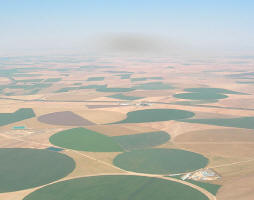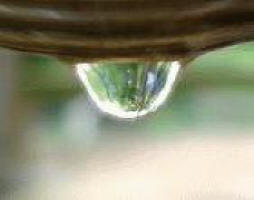 WFD background
WFD background
The increasing demand of citizens and environmental organisations for
cleaner rivers and lakes, groundwater and coastal beaches is one of the main
reasons why the Commission has made water protection one of its priorities.
The emphasis of the WFD is citizen involvement.
Beginnings
The "first wave" of early European water legislation came in 1975, with
standards rivers and lakes used for drinking water, and culminated in 1980
in setting quality targets for drinking water. It also included quality
objective legislation on fishing waters, shellfish waters, bathing waters
and groundwaters. Its main emission control element was the Dangerous
Substances Directive.
Pollution from urban waste water and agriculture
In 1988, the Frankfurt ministerial seminar on water reviewed the existing legislation and identified a number of improvements that could be made and gaps that could be filled. This resulted in the second phase of water legislation, with, in 1991, the adoption of:- the Urban Waste Water Treatment Directive, providing for secondary (biological) waste water treatment, and even more stringent treatment where necessary
- the Nitrates Directive, addressing water pollution by nitrates from agriculture.
- a new Drinking Water Directive, reviewing the quality standards and, where necessary, tightening them (adopted November 1998)
- a Directive for Integrated Pollution and Prevention Control (IPPC), adopted in 1996, addressing pollution from large industrial installations
Citizen involvement for cleaner water: the new European water policy
Pressure for a fundamental rethink of Community water policy came to a head in mid-1995. The Commission, which had already been considering the need for a more global approach to water policy, accepted requests from the European Parliament's environment committee and from the Council of environment ministers.
Whilst EU actions such as the Drinking Water Directive and the Urban Waste Water Directive can duly be considered milestones, European Water Policy had to address the increasing awareness of citizens and other involved parties. At the same time, water policy and water management needed to address problems in a coherent way. This is why the new European Water Policy was developed in an open consultation process involving all interested parties.
The Communication was formally addressed to the Council and the European Parliament, but at the same time invited comment from all interested parties, such as local and regional authorities, water users and non-governmental organisations (NGOs). A score of organisations and individuals responded in writing, most of the comments welcoming the broad outline given by the Commission.
As the culmination of this open process, a two-day Water Conference was hosted in May 1996. The conference was attended by some 250 delegates including representatives of Member States, regional and local authorities, enforcement agencies, water providers, industry, agriculture and consumers and environmentalists.
The outcome of this consultation process was a widespread consensus that, while considerable progress had been made in tackling individual issues, the current water policy was fragmented, in terms both of objectives and of means. All parties agreed on the need for a single piece of framework legislation to resolve these problems. In response to this, the Commission presented a Proposal for a Water Framework Directive with the following key aims:
- expanding the scope of water protection to all waters, surface waters and groundwater
- achieving "good status" for all waters by a set deadline
- water management based on river basins
- "combined approach" of emission limit values and quality standards
- getting the prices right
- getting the citizen involved more closely
- streamlining legislation
A single system of water management:
river basin management
The best model for a single system of water management is management
according to river basin - the natural geographical and hydrological unit -
instead of according to administrative or political boundaries. Initiatives
taken forward by the States concerned for the Maas, Schelde or Rhine river
basins have served as positive examples of this approach, with their
cooperation and joint objective-setting across Member State borders, or, in
the case of the Rhine, beyond EU territory. While several Member States
already take a river basin approach, this is at present not the case
everywhere. For each river basin district - some of which traverse national
frontiers - a "river basin management plan" will need to be established and
updated every six years, and this provides the context for the co-ordination
requirements identified above.
Good status for all waters by a
set deadline
There are a number of objectives in respect of which the quality of water
is protected. The key ones at European level are general protection of the
aquatic ecology, specific protection of unique and valuable habitats,
protection of drinking water resources, and protection of bathing water. All
these objectives must be integrated for each river basin. It is clear that
the last three – special habitats, drinking water areas and bathing water –
apply only to specific bodies of water (those supporting special wetlands;
those identified for drinking water abstraction; those generally used as
bathing areas). In contrast, ecological protection should apply to all
waters: the central requirement of the Treaty is that the environment be
protected to a high level in its entirety.
Surface water
Ecological protection
For this reason, a general requirement for ecological protection, and a
general minimum chemical standard, was introduced to cover all surface
waters. These are the two elements: "good ecological status" and "good
chemical status". Good ecological status is defined in Annex V of the Water
Framework Proposal, in terms of the quality of the biological community, the
hydrological characteristics and the chemical characteristics. As no
absolute standards for biological quality can be set which apply across the
Community, because of ecological variability, the controls are specified as
allowing only a slight departure from the biological community which would
be expected in conditions of minimal anthropogenic impact. A set of
procedures for identifying that point for a given body of water, and
establishing particular chemical or hydromorphological standards to achieve
it, is provided, together with a system for ensuring that each Member State
interprets the procedure in a consistent way (to ensure comparability). The
system is somewhat complicated, but this is inevitable given the extent of
ecological variability, and the large number of parameters, which must be
dealt with.
Chemical protection
Good chemical status is defined in terms of compliance with all the
quality standards established for chemical substances at European level. The
Directive also provides a mechanism for renewing these standards and
establishing new ones by means of a prioritisation mechanism for hazardous
chemicals. This will ensure at least a minimum chemical quality,
particularly in relation to very toxic substances, everywhere in the
Community.
Other uses
As mentioned above, the other uses or objectives for which water is protected apply in specific areas, not everywhere. Therefore, the obvious way to incorporate them is to designate specific protection zones within the river basin that must meet these different objectives. The overall plan of objectives for the river basin will then require ecological and chemical protection everywhere as a minimum, but where more stringent requirements are needed for particular uses, zones will be established and higher objectives set within them.
There is one other category of uses that does not fit into this picture.
It is the set of uses that adversely affect the status of water but that are
considered essential on their own terms – they are overriding policy
objectives. Key examples are flood protection and essential drinking water
supply, and the problem is dealt with by providing derogations from the
requirement to achieve good status for these cases, so long as all
appropriate mitigation measures are taken. Less clear-cut cases are
navigation and power generation, where the activity is open to alternative
approaches (transport can be switched to land, other means of power
generation can be used). Derogations are provided for those cases also, but
subject to three tests: that the alternatives are technically impossible,
that they are prohibitively expensive, or that they produce a worse overall
environmental result.
Groundwater
Chemical status
The case of groundwater is somewhat different. The presumption in
relation to groundwater should broadly be that it should not be polluted at
all. For this reason, setting chemical quality standards may not be the best
approach, as it gives the impression of a permissable level of pollution.
Very few such standards have been established at European level for
particular issues (nitrates, pesticides and biocides), and these must always
be adhered to. But for general protection, we have taken another approach.
It is essentially a precautionary one. It comprises a prohibition on direct
discharges to groundwater, and (to cover indirect discharges) a requirement
to monitor groundwater bodies so as to detect changes in chemical
composition, and to reverse any antropogenically induced upward pollution
trend. Taken together, these should ensure the protection of groundwater
from all contamination, according to the principle of minimum anthropogenic
impact.
Quantitative status
Quantity is also a major issue for groundwater. Briefly, the issue can be put as follows. There is only a certain amount of recharge into a groundwater each year, and of this recharge, some is needed to support connected ecosystems (whether they be surface water bodies, or terrestrial systems such as wetlands). For good management, only that portion of the overall recharge not needed by the ecology can be abstracted – this is the sustainable resource, and the Directive limits abstraction to that quantity.
One of the innovations of the Directive is that it provides a framework
for integrated management of groundwater and surface water for the first
time at European level.
Coordination of measures
There are a number of measures taken at Community level to tackle particular pollution problems. Key examples are the Urban Waste Water Treatment Directive and the Nitrates Directive, which together tackle the problem of eutrofication (as well as health effects such as microbial pollution in bathing water areas and nitrates in drinking water); and the Integrated Pollution Prevention and Control Directive, which deals with chemical pollution. The aim is to coordinate the application of these so as to meet the objectives established above. This is done as follows.
First, the objectives are established for the river basin as outlined in
the previous section. Then, an analysis of human impact is conducted so as
to determine how far from the objective each body of water is. At this
point, the effect on the problems of each body of water of full
implementation of all existing legislation is considered. If the existing
legislation solves the problem, well and good, and the objective of the
framework Directive is attained. However, if it does not, the Member State
must identify exactly why, and design whatever additional measures are
needed to satisfy all the objectives established. These might include
stricter controls on polluting emissions from industry and agriculture, or
urban waste water sources, say. This should ensure full
coordination.
The combined approach
But there is a further aspect. Historically, there has been a dichotomy in approach to pollution control at European level, with some controls concentrating on what is achievable at source, through the application of technology; and some dealing with the needs of the receiving environment in the form of quality objectives. Each approach has potential flaws. Source controls alone can allow a cumulative pollution load, which is severely detrimental to the environment, where there is a concentration of pollution sources. And quality standards can underestimate the effect of a particular substance on the ecosystem, due to the limitations in scientific knowledge regarding dose-response relationships and the mechanics of transport within the environment.
For this reason, a consensus has developed that both are needed in practice - a combined approach. The Water Framework Directive formalises this. It does so as follows. On the source side, it requires that as part of the basic measures to be taken in the river basin, all existing technology-driven, source-based controls must be implemented as a first step. But over and above this, it also sets out a framework for developing further such controls. The framework comprises the development of a list of priority substances for action at EU level, prioritised on the basis of risk; and then the design of the most cost-effective set of measures to achieve load reduction of those substances, taking into account both product and process sources.
On the effects side, it co-ordinates all the environmental objectives in
existing legislation, and provides a new overall objective of good status
for all waters, and requires that where the measures taken on the source
side are not sufficient to achieve these objectives, additional ones are
required.
The river basin management plan
All the elements of this analysis must be set out in a plan for the river
basin. The plan is a detailed account of how the objectives set for the
river basin (ecological status, quantitative status, chemical status and
protected area objectives) are to be reached within the timescale required.
The plan will include all the results of the above analysis: the river
basin’s characteristics; a review of the impact of human activity on the
status of waters in the basin; an estimation of the effect of existing
legislation and the remaining "gap" to meeting these objectives; and a set
of measures designed to fill the gap. One additional component is that an
economic analysis of water use within the river basin must be carried out.
This is to enable a rational discussion on the cost-effectiveness of the
various possible measures. It is essential that all interested parties be
fully involved in this discussion, and indeed in the preparation of the
river basin management plan as a whole.
Public participation
In getting our waters clean, the role of citizens and citizens' groups will be crucial.
There are two main reasons for an extension of public participation. The first is that the decisions on the most appropriate measures to achieve the objectives in the river basin management plan will involve balancing the interests of various groups. The economic analysis requirement is intended to provide a rational basis for this, but it is essential that the process be open to the scrutiny of those who will be affected.
The second reason concerns enforceability. The greater the transparency
in the establishment of objectives, the imposition of measures, and the
reporting of standards, the greater care Member States will take to
implement the legislation in good faith, and the greater the power of
citizens to influence the direction of environmental protection, whether
through consultation or, if disagreement persists, through the complaints
procedures and the courts. Caring for Europe's waters will require more
involvement of citizens, interested parties, non-governmental organisations
(NGOs). To that end, the Water Framework Directive will require information
and consultation when river basin management plans are established: the
river basin management plan must be issued in draft, and the background
documentation on which the decisions are based must be made accessible.
Furthermore a biannual conference in order to provide for a regular exchange
of views and experiences in implementation will be organised. Too often in
the past implementation has been left unexamined until it is too late –
until Member States are already woefully behind schedule and out of
compliance. The Framework Directive, by establishing very early on a network
for the exchange of information and experience between water professionals
throughout the Community, will ensure this does not happen.
Streamlining legislation
One advantage of the framework directive approach, in its own way a significant one, is that it rationalises the Community's water legislation by replacing seven of the "first wave" directives: those on surface water and its two related directives on measurement methods and sampling frequencies and exchanges of information on fresh water quality; the fish water, shellfish water, and groundwater directives; and the directive on dangerous substances discharges. The operative provisions of these directives will be taken over in the framework directive, allowing them to be repealed.
The need to conserve adequate supplies of a resource for which demand is continuously increasing is also one of the drivers behind what is arguably one of the Directive's most important innovations - the introduction of pricing. Adequate water pricing acts as an incentive for the sustainable use of water resources and thus helps to achieve the environmental objectives under the Directive.
Member States will be required to ensure that the price charged to water
consumers - such as for the abstraction and distribution of fresh water and
the collection and treatment of waste water - reflects the true costs.
Whereas this principle has a long tradition in some countries, this is
currently not the case in others. However, derogations will be possible,
e.g. in less-favoured areas or to provide basic services at an affordable
price.
Conclusion
Much progress has been made in water protection in Europe, in individual Member States, but also in tackling significant problems at European level. But Europe's waters are still in need of increased efforts to get them clean or to keep them clean. After 25 years of European water legislation, this demand is expressed, not only by the scientific community and other experts, but to an ever-increasing extent by citizens and environmental organisations. The Water Framework Directive works for the benefit of all Europe’s citizens and waters by:
- getting Europe's waters cleaner
- getting the citizens involved.
 you are not logged in
you are not logged in







